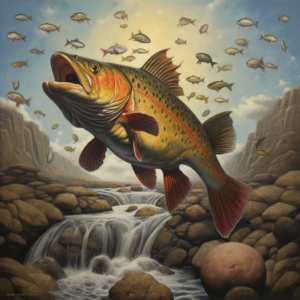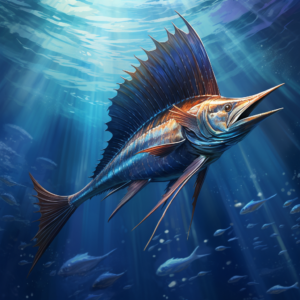Welcome to the comprehensive guide on saltwater fishing, where you’ll learn everything you need to know to become a skilled saltwater angler. Whether you’re a beginner or an experienced angler, this guide is designed to help you master the art of fishing in saltwater environments. From essential gear and equipment to effective fishing techniques and tips, we’ll cover everything you need to know to enhance your fishing experience. Fishing is not just a sport but a way of life, and we’re excited to share our knowledge and passion for saltwater fishing with you. So let’s dive into the fascinating world of ocean fishing and explore the possibilities of this thrilling and rewarding activity.
Essential Fishing Gear for Saltwater Anglers
Fishing gear is the heart and soul of any angler, and this is particularly true for saltwater fishing. Saltwater environments pose unique challenges that require specialized equipment to make a catch. Here are the must-have fishing gear items every saltwater angler should consider:
Fishing Rods and Reels
You can’t go fishing without a rod and reel. When it comes to saltwater fishing, you need a sturdy rod with a high line weight capacity and durable reels that can handle the corrosive saltwater environment. Look for rods and reels made with quality materials such as graphite and aluminum, and choose models that are designed specifically for saltwater fishing.
Fishing Lines and Leaders
The right line and leader are crucial for a successful saltwater fishing trip. The harsh saltwater environment requires a line that is strong, abrasion-resistant, and can withstand the heavy currents and strong winds. A fluorocarbon leader can also be helpful in attracting fish and preventing bite-offs.
Fishing Lures and Baits
Choosing the right lure or bait can make or break a saltwater fishing trip. Depending on the type of fish you want to catch, you may need to use live bait, cut bait, or a variety of lures such as jigs, topwater plugs, and soft plastics. It’s important to have a good selection of lures and baits so you can adapt to changing conditions and fish behavior.
Fishing Accessories
There are a number of accessories that can make your saltwater fishing trip more comfortable and enjoyable. Consider investing in a quality fishing hat, sunglasses, polarized lenses, sunscreen, and a sturdy fishing bag to store your gear. It’s also a good idea to carry a first aid kit, a knife, and a waterproof phone case in case of emergencies.
In Conclusion
Choosing the right fishing gear is essential for a successful saltwater fishing trip. Investing in quality gear that is designed specifically for saltwater environments can help you catch more fish and make the most of your time on the water.
Choosing the Right Fishing Rods and Reels for Saltwater Fishing
When it comes to saltwater fishing, choosing the right fishing rods and reels is crucial. With so many different options available, it can be overwhelming to make a decision. Here are some factors to consider when selecting your fishing gear.
Fishing Rods
The first thing to consider when selecting a saltwater fishing rod is the length. Longer rods are better for casting longer distances, while shorter rods provide better accuracy and control. Additionally, you’ll want to consider the power and action of the rod. Power refers to the rod’s strength, while action refers to the flexibility. A fast action rod is more sensitive and better for detecting bites, while a slow action rod provides more bend and is better for fighting larger fish. Finally, consider the material of the rod. Graphite and fiberglass are the most common materials used in saltwater fishing rods.
Fishing Reels
When selecting a saltwater fishing reel, you’ll need to consider the type of fishing you’ll be doing. Spinning reels are versatile and easy to use, making them a popular choice for beginners. Baitcasting reels, on the other hand, provide greater accuracy and control, making them a better option for more experienced anglers. You’ll also need to consider the reel’s drag system, which helps control the fish during the fight. Finally, consider the size and line capacity of the reel, which should correspond to the size of your fishing rod.
Pro Tip: When selecting your fishing gear, consider the species of fish you’re targeting and the environment you’ll be fishing in. This will help ensure that you have the appropriate gear for the job.
Mastering Saltwater Fishing Techniques
Congratulations, you’ve got all the gear you need! Now it’s time to master the techniques that will make you a successful saltwater angler. By learning and practicing these techniques, you’ll be able to hook and reel in even the most elusive fish. Here are some tips to get you started:
Bait Fishing Techniques
Bait fishing is a popular technique used to catch a wide range of saltwater fish. The key to successful bait fishing is choosing the right bait and presenting it in a way that attracts fish. Some of the most popular bait options include live bait, cut bait, and artificial bait. Experiment with different types of bait to see which works best for the fish you’re targeting.
Trolling Techniques
Trolling is a technique used to cover a large area of water and attract fish that are in search of food. To troll effectively, you’ll need to have a good understanding of the type of fish you’re targeting and the depth at which they’re most likely to be swimming. Use lures that mimic the fish’s natural prey to increase your chances of success.
Bottom Fishing Techniques
Bottom fishing is a technique used to catch fish that swim near the ocean floor. This technique is especially effective when targeting bottom-dwelling fish such as flounder, snapper, and grouper. When bottom fishing, it’s important to use the right type of bait and weight to keep it close to the bottom. Keep your line tight and be prepared to set the hook quickly when you feel a tug on the line.
Casting Techniques
Casting is a fundamental technique that every angler should master. Casting involves using a rod and reel to cast your line out to a specific location in the water. To cast effectively, you’ll need to have good timing, power, and accuracy. Practice your casting technique regularly to improve your skills and increase your chances of catching fish.
Drift Fishing Techniques
Drift fishing is a technique used to cover a large area of water while allowing your bait to move along with the current. This technique is especially effective when targeting pelagic fish such as tuna and marlin. Use a drift rig to keep your bait at the right depth and monitor your line closely for any signs of a bite.
By mastering these saltwater fishing techniques, you’ll be well on your way to becoming a successful angler. Remember to always be patient and persistent, and never stop learning and practicing. Happy fishing!
Proven Tips for Saltwater Fishing Success
Whether you’re a seasoned saltwater angler or just starting out, these tips can help you increase your chances of a successful fishing trip:
TIP: Pay attention to the tides and currents. Fish are more likely to be active during certain tide phases and feeding times. Research the tide charts and plan your fishing accordingly.
Another important aspect is choosing the right bait for the species you’re targeting. Different fish have different preferences and feeding habits. Consider the location and the time of day when selecting your bait.
TIP: Keep your fishing gear and tackle organized and in good condition. This will save you time and frustration on the water, and increase your chances of landing a big catch.
Patience is key when saltwater fishing. Don’t give up too soon if you’re not getting bites. Try different techniques, baits, and locations until you find what works for you.
TIP: When reeling in your catch, use a smooth and steady motion. Avoid jerky movements that can cause the fish to escape or damage your fishing line.
Finally, observe and learn from experienced anglers. Watch their techniques, ask questions, and take notes. They may have valuable insights and tips that can help you improve your skills.
Remember:
These tips are just the beginning. Saltwater fishing is a complex and exciting sport that requires continuous learning and practice. Keep exploring, experimenting, and having fun!
Exploring Common Saltwater Fishing Challenges and Solutions
As a saltwater angler, you may face several challenges that can make your fishing trip less enjoyable. However, with the right techniques and equipment, you can overcome these obstacles and increase your chances of success.
Battling Strong Currents
One of the most common challenges in saltwater fishing is dealing with strong currents. To overcome this challenge, try fishing in areas with calmer waters, such as protected bays or coves. If you must fish in a current, position yourself upstream and use a heavier weight to keep your bait closer to the bottom.
Fighting Bigger Fish
When it comes to saltwater fishing, bigger fish are often the target. However, landing them can be a challenge. To increase your chances of success, use a rod with a higher weight capacity and a reel with a strong drag system. It’s also important to have a good grip on your rod and maintain a constant tension on the fish.
Maintaining Equipment in a Saltwater Environment
Exposure to saltwater can cause damage to your fishing equipment over time. To prevent this, rinse your equipment with freshwater after each use and lubricate your reel to prevent rust and corrosion. It’s also a good idea to store your gear in a dry, cool place to avoid any damage from moisture.
Choosing the Right Fishing Techniques
There are several techniques for saltwater fishing, and choosing the right one can make all the difference. Some of the most effective techniques include trolling, bottom fishing, and jigging. Experiment with different techniques to find what works best for you in different situations.
Investing in Quality Fishing Equipment
Investing in quality fishing equipment can go a long way in overcoming common saltwater fishing challenges. Look for rods and reels that are specifically designed for saltwater fishing, and make sure to choose gear that matches the type of fish you’re targeting. Quality gear may cost more, but it’s worth the investment in the long run.
By following these tips and strategies, you can overcome common saltwater fishing challenges and have a more enjoyable and successful fishing experience. Remember to always be prepared and flexible, and continue learning and practicing to become a skilled saltwater angler!
The Art of Saltwater Lure Fishing
Using lures for saltwater fishing can be both thrilling and rewarding. It’s a technique that requires skill and patience, but the right strategy and lure can help you reel in that big catch you’ve been dreaming of.
There are various types of lures to choose from, including surface lures, sinking lures, and jigs. Each type has its own unique uses and strengths, so it’s important to select the right one based on the fish you’re targeting and the conditions you’re fishing in.
Surface lures are designed to float on the water’s surface and mimic the movements of prey, such as baitfish or insects, to attract fish from below. They’re great for targeting aggressive fish that feed near the surface, like striped bass or bluefish.
Sinking lures, on the other hand, are designed to sink below the surface and mimic the movements of prey in the water column. They’re great for targeting fish that feed at various depths, such as tuna or mahi-mahi.
Jigs are versatile lures that can be used for both casting and vertical jigging. They’re designed to imitate the movements of various prey, such as squid or shrimp, and are great for targeting bottom-dwelling fish like flounder or grouper.
When using lures, it’s important to pay attention to the movement and action of the lure. Varying your retrieval speed, jerking the rod tip, or pausing the lure can all make a difference in attracting a bite.
It’s also important to choose the right size and color of lure based on the fish you’re targeting and the conditions you’re fishing in. Bright colors like chartreuse or pink can be effective in murky water, while darker colors like black or brown can be more effective in clear water.
Ultimately, the key to successful lure fishing in saltwater is to experiment and find what works best for you. With the right technique, strategy, and lure selection, you can increase your chances of catching that trophy fish you’ve been dreaming of.
The Saltwater Angler's Handbook: A Guide to Ocean Fishing
Congratulations! You’ve just completed reading our comprehensive guide on saltwater fishing. By now, you should have a good understanding of the essential gear and equipment needed for a successful fishing trip in the ocean. You’ve also learned how to choose the right fishing rods and reels, master various saltwater fishing techniques, and use lures and bait to attract and hook your desired catch.
But don’t stop here! Remember, the art of saltwater fishing requires practice and continuous learning. Keep exploring the vast world of ocean fishing with passion and enthusiasm. Remember to stay up-to-date on the latest fishing tips and techniques.
Finally, we hope that our guide has inspired you to take your next saltwater fishing trip. Whether you’re a seasoned angler or a beginner, there’s always something new to discover in the endless blue. Happy fishing!
FAQ
Q: What will I learn from The Saltwater Angler’s Handbook: A Guide to Ocean Fishing?
A: The Saltwater Angler’s Handbook is a comprehensive guide that will teach you everything you need to know about saltwater fishing. You’ll learn essential fishing gear, techniques, and tips for success in the ocean.
Q: What gear do I need for saltwater fishing?
A: Essential gear for saltwater fishing includes fishing rods, reels, lines, lures, and tackle. These items are necessary to ensure a successful fishing trip in the ocean.
Q: How do I choose the right fishing rods and reels for saltwater fishing?
A: When selecting fishing rods and reels for saltwater fishing, consider factors such as the type of fish you want to catch, the fishing technique you’ll be using, and the durability of the equipment in a saltwater environment.
Q: What are some effective saltwater fishing techniques?
A: There are various saltwater fishing techniques you can use, including bait fishing, trolling, and lure fishing. Each technique has its own advantages and can increase your chances of catching fish in the ocean.
Q: Can you provide some tips for saltwater fishing success?
A: Absolutely! To improve your saltwater fishing experience, understanding tides and currents, choosing the right bait and location, and being patient and observant are essential. These tips will greatly enhance your chances of success.
Q: What are some common challenges in saltwater fishing and how can I overcome them?
A: Saltwater fishing can present challenges such as dealing with strong currents, battling bigger fish, and maintaining equipment in a saltwater environment. To overcome these challenges, we’ll provide solutions and strategies to help you navigate these obstacles.
Q: How can I effectively use lures for saltwater fishing?
A: The art of saltwater lure fishing involves understanding different types of lures, knowing how to use them effectively, and using the best techniques to attract and hook saltwater fish. We’ll guide you through this process to increase your chances of success.
Q: What should I take away from The Saltwater Angler’s Handbook?
A: The Saltwater Angler’s Handbook is a comprehensive guide to ocean fishing. By reading this guide, you’ll gain valuable knowledge, skills, and techniques that will help you become a skilled saltwater angler. Continuous learning and practice are key to mastering this exhilarating sport.




